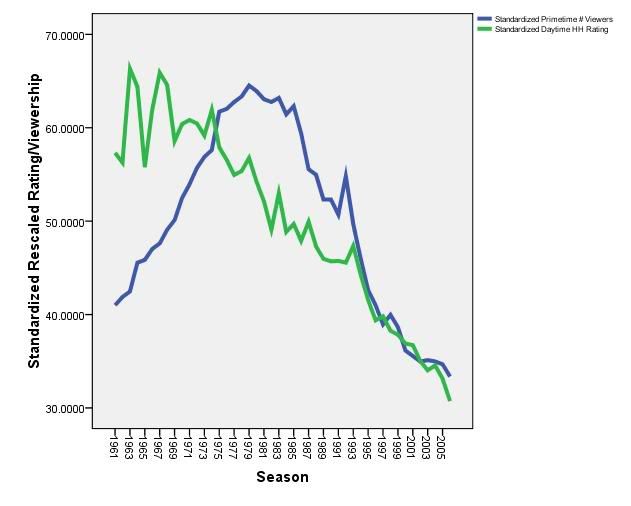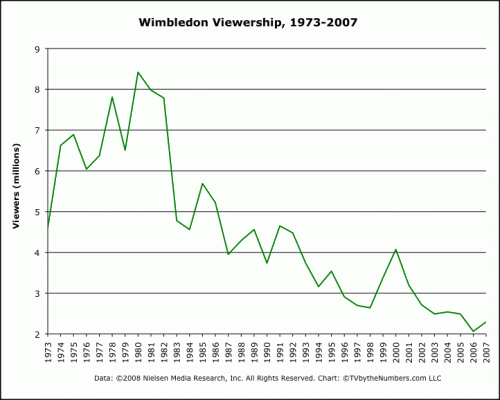Daytime Confidential's J. Bernard Jones has written the kind of detailed, analytic, insightful, contrarian essay about daytime's survival that simply begs rereading and rereading.
The crux of this post is this picture. It puts daytime and primetime US network ratings on a common scale, and then compares them for the past 50+ years. As you can see, a key point of J. Bernard's is absolutely correct: We must not over-focus on daytime ratings decline. The daytime decline is clearly part of a much larger phenomenon. In this picture, daytime (green) and primetime (blue) have been in a completely overlapping death spiral since at least the 1980s! I'll return to this picture again below.

I don't do Mr. Jones justice by paraphrasing him, but that won't stop me. Basically, he challenges all of us nattering nabobs of negativism who keep proclaiming the imminent end of daytime soaps. Beyond wondering if we're guided by a kind of Schadenfreude (putting it "out there in the universe" to make it true), he suggests that an exclusive focus on daytime ratings ignores the broader context of what is happening to the networks in general. He reminds us that the whole enterprise of network TV is doing badly, so daytime may be doing relatively okay. Moreover, daytime delivers a reliable (if shrinking) niche demographic that no alternative format can deliver. Every attempt to replace soaps, he points out, has yielded an even less successful alternative. Finally, he suggests that retreat only exacerbates the decline of daytime. NBC is in the trouble it is in, he suggests, because it has systematically turned its back and squandered its audience.
His is an essay of such richness and complexity, it really demands careful consideration. I would like to do that over the next 3 blog posts.
In Part 1 (this part), I'm going to examine his thesis that daytime is not the only thing falling. I've been struggling to get a bigger handle on just how much things ARE falling everwhere in the old, advertiser supported media.
In Part 2, I want to consider WHY people (including me) are so intent on proclaiming that "the sky is falling". It is an ardent "death pool" out there on the internet boards (and in the mainstream media, as J. Bernard proclaims). But why? What function does it serve?
In Part 3, I hope to address why -- as much as I love his blog entry-- I think J. Bernard is wrong. The sky IS falling. Daytime is just about done. At the same time, I agree with him...this is just the selection pressure that will give rise to the evolution.
=========
Part 1. On the ubiquity of the decline.
It really is quite striking. J. Bernard is right. Daytime ratings are not the only things falling.
TVBythenumbers has this useful set of data and illustrations:

So it is clear: The audience for TV is actually growing...but it is also GOING: to cable.
Going further back, you'll see something familiar: The same "inverted U" that we see for daytime. US network ratings have been in freefall for a very long time.

Now, since I have the EXACT same data period for soaps, I really want to find a way to compare the two set of ratings. In order to do this, what I need to do is figure out how to put the ratings for daytime into the same "metric" (range of values) as these primetime figures.
To accomplish that, I used a process called 'standardization'. I can explain this more for those who want it, but for now, suffice it to say that I took the daytime average and the primetime average, and (a) I averaged across all daytime shows, (b) I I averaged across all primetime networks, and (c) I converted them into something called T-scores (scores that have an average of 50 and a standard deviation of 10). I return now to the figure I posted at the top of this blog entry, which shows you what happens.

It appears J. Bernard has a point! Look at the period since the early 1990s. The slope of the decline is IDENTICAL for primetime (blue) and daytime (green)!
Juxtaposing the two sets of numbers adds another fascinating insight. Daytime (green) was on the leading edge of the decline, showing clear evidence of decline for the last 3-4 decades. Primetime (blue), in contrast, was continuing to build through the late 70s. But then, when decline set in...the trajectory quickly emulated that of daytime. The amazing lockstep decline of the two figures is...breathtaking!
So, yes, daytime is not alone. In my words: "The sky is falling, but not just over the daypart".
I'll close this post by noting that a lot of old media are going through virtually identical trajectories. It is not just daytime, and that is worth noting. The underlying sociological phenomenon is one we really need to understand better. The figure above from TVBytheNumbers suggests we can understand much of the network decline as "loss to cable". But a similar fractionation and movement to new media seems to be causing a ubiquitous loss to traditional methods of dissemination.
There are newspapers:

There is the recording industry:

Even Wimbledon viewership follows the trend:

So, when your friends tell you "Soaps are sinking because the quality sucks", can you PLEASE tell them it's more complicated than that! J. Bernard told us so, and he is right.

No comments:
Post a Comment